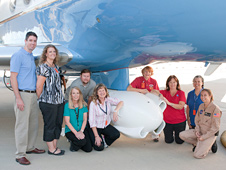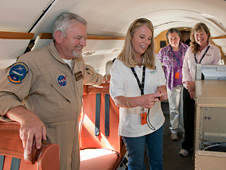 Six master elementary and high school teachers who participated in earthquake and soil moisture research flights aboard NASA’s Gulfstream III research aircraft during the AREES program gather around the UAVSAR pod mounted underneath the aircraft. From left, AREES project manager Shaun Smith, teachers Sonja Squires, Bobbie Mitchell, Doug Phelps, Marie Blue, Marlene McShea, AREES faculty consultant Vikki Costa of California State University at Fullerton, teacher Julie Bookman and NASA Dryden engineering operations specialist Michelle Haupt. (NASA photo / Tom Tschida
Six master elementary and high school teachers who participated in earthquake and soil moisture research flights aboard NASA’s Gulfstream III research aircraft during the AREES program gather around the UAVSAR pod mounted underneath the aircraft. From left, AREES project manager Shaun Smith, teachers Sonja Squires, Bobbie Mitchell, Doug Phelps, Marie Blue, Marlene McShea, AREES faculty consultant Vikki Costa of California State University at Fullerton, teacher Julie Bookman and NASA Dryden engineering operations specialist Michelle Haupt. (NASA photo / Tom Tschida
A half-dozen enthusiastic Southern California elementary and high school teachers learned to use NASA education resources this summer while indentifying and creating new educational opportunities for teachers and students through the agency’s Airborne Research Experiences for Educators and Students program.
The six educators from Santa Clarita, Los Angeles, Lancaster and Palmdale were competitively selected to participate in an AREES summer workshop held June 21 through July 16 in Palmdale, Calif. The workshop was designed to help participants identify and implement educator and student activities in the areas of science, technology, engineering and math, or STEM, disciplines that leverage the wide variety of aircraft, flight missions and research opportunities across NASA.
The AREES initiative supports NASA’s commitment to STEM education by providing K-12 educators and students with NASA content-based resources, materials and instructional and enrichment activities. Through the program, teachers are developing curricula and activities for the upcoming school year,
On June 29 and again on July 8, the group participated in science missions flown by a Gulfstream-III research aircraft equipped with a sophisticated synthetic aperture radar system developed by NASA’s Jet Propulsion Laboratory. The flights from the Dryden Aircraft Operations Facility in Palmdale, Calif., collected radar data for earthquake and soil moisture studies, and provided the educators with insight on NASA ‘s collection methodology.
Participating in the mission “made me realize that I have been missing the boat entirely by not having such incredible, high-level, stimulating activities that align with the students’ curriculum standards,” said Bobbie Mitchell, an eighth-grade algebra teacher at Lancaster’s Amargosa Creek Middle School. “I need to get students excited about learning and show them that they have a great future here in the Antelope Valley.”
In her classes, Mitchell said she begins each school year by asking students, “Who likes math?” Often, she says, no one raises a hand.
But another of the six educators chosen for the workshop, Maria Blue, a first-grade teacher at Santa Clarita’s Plum Canyon Elementary School, said her students often say that they like math, leading Mitchell and Blue to wonder what happens to make students lose interest in math between elementary and middle school.
The other teachers who were involved in this summer’s AREES program were Marlene McShea, who teaches biology and chemistry at Lancaster’s Paraclete High School; Julie Bookman, a biology teacher at Palmdale High School; Douglas Phelps, who teaches chemistry at the SAGE Academy at Belmont High School in Sherman Oaks, Calif.; and Sonja Steffan-Squires, a science teacher at Joe Walker Middle School in Quartz Hill, Calif.
 Senior science advisor Tom Mace of NASA Dryden’s Science Missions Directorate shares a light moment with teachers Bobbie Mitchell, Julie Bookman and Maria Blue as they prepare for a environmental research flight on NASA’s Gulfstream III during the AREES teacher workshop. (NASA photo /Tom Tschida) (NASA photo / Tom Tschida)
Senior science advisor Tom Mace of NASA Dryden’s Science Missions Directorate shares a light moment with teachers Bobbie Mitchell, Julie Bookman and Maria Blue as they prepare for a environmental research flight on NASA’s Gulfstream III during the AREES teacher workshop. (NASA photo /Tom Tschida) (NASA photo / Tom Tschida)
“AREES provides a way for educators to engage in cutting-edge airborne science research and technology,” said Vikki Costa, a faculty consultant from California State University Fullerton. “The program includes guidance in the translation of these experiences into multi-disciplinary K-12 curricula that provides students with the most current information about critical science issues including climate change, weather and earthquake monitoring. Through investigations, engineering design challenges, and project-based learning, students also explore future careers in STEM fields.”
The AREES program goal is to stimulate interest in NASA’s Earth Science research and, with the help of educators, support recruitment of the agency’s future engineers and scientists, said AREES project manager Shaun Smith.
“We use unique NASA resources to inspire the next generation of explorers,” Smith added. “We’re doing that through the aircraft, the missions and the science behind the missions. We have access to platforms, technical personnel and access to actual flights.”
Smith said the ultimate goal of the summer program is to make the instructional materials developed by teachers in the AREES workshops available at the national level, as well as to extend the program to other areas across the nation.
The six teachers who participated in this year’s AREES workshop will receive professional development hours that can be applied toward maintaining their teaching credential. They also have the option to receive three graduate-level credits from California State University, Fullerton.
The AREES program is co-sponsored by NASA Dryden Flight Research Center’s Office of Education and the Teaching From Space program at NASA’s Johnson Space Center in Houston, in partnership with the Aerospace Education Research and Operations Institute in Palmdale, Calif., and California State University, Fullerton.
– end –
text-only version of this release
To receive status reports and news releases issued from the Dryden Newsroom electronically, send a blank e-mail message to dfrc-subscribe@newsletters.nasa.gov. To unsubscribe, send a blank e-mail message to dfrc-unsubscribe@newsletters.nasa.gov. The system will confirm your request via e-mail.
Leslie Williams
NASA Dryden Flight Research Center
(661) 276-3893
leslie.a.williams@nasa.gov

























